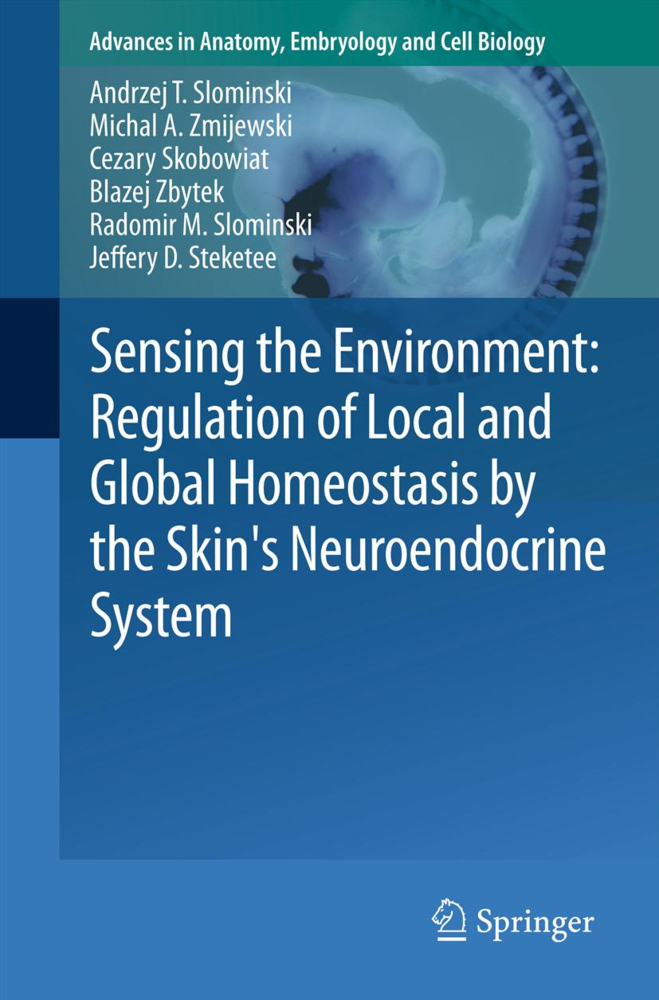Sensing the Environment: Regulation of Local and Global Homeostasis by the Skin's Neuroendocrine System
The skin, the body's largest organ, is strategically located at the interface with the external environment where it detects, integrates and responds to a diverse range of stressors, including solar radiation. It has already been established that the skin is an important peripheral neuroendocrine-immune organ that is closely networked with central regulatory systems. These capabilities contribute to the maintenance of peripheral homeostasis. Specifically, epidermal and dermal cells produce and respond to classical stress neurotransmitters, neuropeptides and hormones, production which is stimulated by ultraviolet radiation (UVR), biological factors (infectious and non-infectious) and other physical and chemical agents. Examples of local biologically active products are cytokines, biogenic amines (catecholamines, histamine, serotonin and N-acetyl-serotonin), melatonin, acetylocholine, neuropeptides including pituitary (proopiomelanocortin-derived ACTH, b-endorphin or MSH peptides, thyroid stimulating hormone) and hypothalamic (corticotropin-releasing factor and related urocortins, thyroid-releasing hormone) hormones, as well as enkephalins and dynorphins, thyroid hormones, steroids (glucocorticoids, mineralocorticoids, sex hormones, 7-d steroids), secosteroids, opioids and endocannabinoids. The production of these molecules is hierarchical, organized along the algorithms of classical neuroendocrine axes such as the hypothalamic pituitary adrenal axis (HPA), hypothalamic-thyroid axis (HPT), serotoninergic, melatoninergic, catecholaminergic, cholinergic, steroid/secosteroidogenic, opioid and endocannabinoid systems. Disruptions of these axes or of communication between them may lead to skin and/or systemic diseases. These local neuroendocrine networks also serve to limit the effect of noxious environmental agents to preserve local and consequently global homeostasis. Moreover, the skin-derived factors/systems can also activate cutaneous nerve endingsto alert the brain to changes in the epidermal or dermal environments, or alternatively to activate other coordinating centers by direct (spinal cord) neurotransmission without brain involvement. Furthermore, rapid and reciprocal communications between epidermal and dermal and adnexal compartments are also mediated by neurotransmission including antidromic modes of conduction. Lastly, skin cells and the skin as an organ coordinate and/or regulate not only peripheral but also global homeostasis.
Introduction
Biogenic amines in the skinMelatoninergic system in the skin
Cutaneous cholinergic system
Corticotropin signaling system in the skin
Steroidogenesis in the skin
Equivalent of hypothalamo-pituitary adrenal axis in the skin
Cutaneous secosteroidal system
Equivalent of hypthalamic-pituitary-thyroid axis
Cutaneous opioid system
Cutaneous endocannabinoid system
Perspectives
References.
Slominski, Andrzej T.
Zmijewski, Michal A.
Skobowiat, Cezary
Zbytek, Blazej
Slominski, Radomir M.
Steketee, Jeffery D.
| ISBN | 978-3-642-19682-9 |
|---|---|
| Artikelnummer | 9783642196829 |
| Medientyp | Buch |
| Copyrightjahr | 2011 |
| Verlag | Springer, Berlin |
| Umfang | XV, 115 Seiten |
| Abbildungen | XV, 115 p. 23 illus., 17 illus. in color. |
| Sprache | Englisch |









